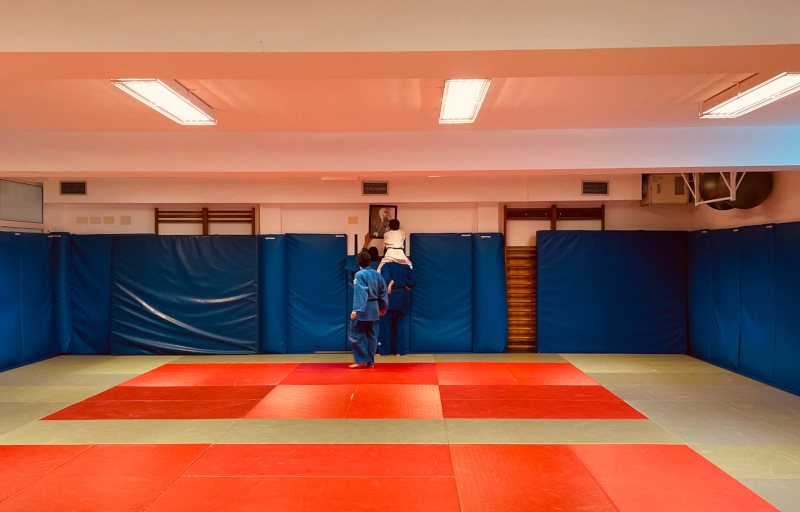On Judo grading ¶
永き日を囀りたらぬ雲雀かな
It’s been 12 years since I started Judo. I love it to the same extent I find it difficult (sometimes painstakingly so). My practice has had ups and downs, with some relatively large gaps in there as well, the biggest one due to my shoulder surgery that put me out of commission for a couple of years: I would say that injury-related absences are a bit over 3 years if taken together. I’ve tried to have a consistent 3x/week average, something which I only achieved in the last third of this decade-long period, which is as expected the one where I also saw my most noticeable progress – keeping regular attendance with work, family, and all the rest life’s throws one’s way is not trivial, and there’s a certain degree of pain tolerance involved that will be familiar to judoka.
That to say that the time has come to go for shodan, which (more so in the West) carries an undeniable symbolic weight: for all purposes, a “black belt” is seen as a sign of proficiency, and no amount of “the first dan is more a statement that the fundamentals are there and that more structured learning can begin” easily changes that.
Reflecting on this decision, several topics that are constantly debated
in the Judo community (especially in the resisting internet forums, with
/r/judo arguably being the biggest one currently) come to mind:
- How long does it take to reach black belt in Judo?
- Should everyone be able to reach black belt?
- What are the requirements in different countries?
This is nothing more than a small personal reflection on these topics.
How long does it take to reach black belt in Judo? ¶

My eldest son making sure that Kanō shihan is well positioned
Since I haven’t reached it yet, my personal experience is limited to saying that I’ve went for it with ~1200 hours of mat time:
octave:1> 4*(9*4.3*2.5)+7*(9*4.3*3) ans = 1199.7
This Octave transcript 2 shows an average calculation of my journey, with 4 years of ~2.5 hours per week (with each year having 9 months of active practice, accounting vacations), plus 7 years of 3 hours per week (the real value is likely a bit close to ~1300 due to conservative rounding on my part, and because I’ve tried my best to do 4x/week and even the odd 5x/week recently).
This is almost suspiciously similar to other accounts, for example Dave Roman’s comment on this Reddit thread 3 which points to 1200 hours. Others have mentioned anything in the 1000-1400 range, so for Judo this seems to be a good rule of thumb.
Now, what that this means is a different topic which would lead us to discussing the differences in different martial arts, including the following aspects:
- Commercial approach, and the way grading factors in the business model of different martial arts; this is insignificant to non-existent in Judo, but very relevant in others.
- Relative difficulty of each martial art; this is a sensitive topic since “difficulty” is relative and different people will prioritise different aspects. I don’t think it’s very controversial to say that Judo is difficult, but this is warrants a dedicated discussion.
- The place of a shodan in the overall progression timeline of each art. In Judo, there are broadly speaking 6 kyu grades, and 10 dan grades, which would put shodan along the middle of the path... but we should take into consideration that dan ranks are much rarer than kyu ranks, even amongst those that have kept practising.
- What should a black belt signify from an holistic perspective; especially in Judo which retains a strong ethical focus, should technical and competition merit alone determine it? How to measure anything else?
I will not go into them right now, event though they are worthy of further debate – perhaps topics for future articles.
Should everyone be able to reach black belt? ¶
This is often discussed in terms of “there are some people that are never going to do it”. I would say that yes, everyone who has shown interest, commitment, and dedication should be able to reach black belt; what this means will vary since different persons will have different backgrounds. Obviously, the way to get there will be different and will be harder for some and easier to others, but that’s different from being unreachable.
Different countries have different policies around it, and some are not at all related to dedication or skill; I remember hearing in the Tatami Talk podcast 4 that in the USA background checks are required for shodan, which means that those with a criminal record are not eligible. I won’t go into a lot of details on why I disagree with it (suffice it to say that I find the requirement something that reinforces the injustices in the criminal system itself), but I will say that this is interesting since asking for such a check is against the law in other countries (namely in Europe, and certainly in Portugal specifically) 5.
The most common dimension is however competition and the role it plays in Judo promotion. This is something that is somewhat specific to Judo in the gendai arts, with it being based on three pillars – physical, mental, and moral – and because of it’s role in the Olympic movement: while we can debate when did the emphasis on the “sport” aspect gain more traction (and Lance Gatling’s writing on the history of Judo have been a fundamental source and inspiration on this and other topics), it’s a reality that in some countries the requirement for competition points pose a very real obstacle, especially for adult learners, essentially preventing them from going past 1st kyu.
What are the requirements in different countries? ¶
This is something that I’m currently exploring as well, since I haven’t found a single source comparing the requirements in different countries (and even within countries). My perception is that there are some commonalities like the nage no kata being a requirement, but even that varies when one considers the batsugun system which is focused on a series of wins.
One thing that I find interesting is that there doesn’t seem to exist a relation between difficulty and success: shodan requirements do not seem to be higher in Japan (much to the contrary) and there’s no debate about the quality of Japanese Judo.
In Portugal – and I have no reason to think it’s substantially different from others, especially in the rest of Europe – the requirements for shodan are:
- >= 15 years old.
- >= 1 year as 1st kyu
- Participation in at least 6 official competitions in their current rank.
The evaluation is made on the following, for the “regular” path:
- Yaku-soku-geiko
- The first 4 groups of the gokyo (32 techniques)
- Katame-waza (8 osaekomiwaza, 6 shimewaza, 4 kansetsuwaza)
- Assorted aspects like kuzushi, ukemi, rei-ho, etc.
- The Nage no kata
For those opting for the “quick path” (which can be due to competition participation, but also for other contributions to Judo on a continuous basis), it’s the first 2 groups of the gokyo, about half of the katame-waza techniques, and only the first three groups of the Nage no kata.
This is simpler, but the difference is not insurmountable.
The skylark’s song. ¶
As far as shodan is concerned, I’ll give it a go, and regardless of the outcome, it will be another learning experience: as the skylark, I still find in me the strength to sing a bit more.
